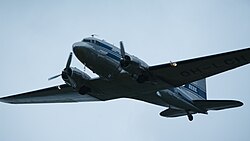1946 C-53 Skytrooper crash on the Gauli Glacier

A Douglas C-47C Skytrain similar to the accident aircraft
|
|
| Accident summary | |
|---|---|
| Date | 18 November 1946 |
| Summary | Weather related Controlled Flight Into Terrain |
| Site | Gauli Glacier |
| Passengers | 8 |
| Crew | 4 |
| Aircraft type | Douglas C-53D Skytrooper |
| Operator | United States Air Force (USAF) |
| Registration | 42-68846 |
| Flight origin | Tulln (near Vienna (Austria) |
| Stopover | Munich (Germany) |
| 1st stopover | Strasbourg (France) |
| 2nd stopover | Dijon (France) |
| Last stopover | Marseille-Istres (France) |
| Destination | Pisa (Italy) |
The C-53 Crash on the Gauli Glacier in the Bernese Alps, (Switzerland) on 19 November 1946 was a turning point in alpine rescue and an international media event. The aircraft, coming from Tulln, Austria (near Vienna), bound for Pisa, Italy, collided with the Gauli Glacier in poor visibility. On board were eight passengers (among them two high-ranking officers of the U.S. armed forces, four women and one 11-year-old girl) and four crew. Several people were injured, but there were no fatalities.
On 18 November 1946 the C-53 Skytrooper military transport aircraft, (serial no. 42-68846) – a military, passenger-only, variant of the civilian Douglas DC-3 airliner – took off from Tulln Air Base near Vienna, Austria, bound for Pisa, Italy. The route planning was affected by bad weather, so they chose a route (950 km) via Munich, Strasbourg, Dijon and Marseille-Istres, to arrive in Pisa two days later.
Having already avoided several alpine peaks in instrument meteorological conditions, near Innsbruck, the crew became disoriented, and on 18 November at 2.45 PM, the aircraft crash-landed on the Gauli Glacier with a speed of 174 mph (280 km/h) at an altitude of 10,990 ft (3,350 m) because of the sudden onset of a Katabatic wind, the aircraft sliding over ice and snow upwards, slowing down rapidly.
The crew thought the aircraft had crashed in the French Alps. An hour after the crash, the crew was able to send emergency radio messages which were received at Orly Airport and at the Istres-Le Tubé Air Base near Marseille, tri-angulating their position in the Airolo-Sion-Jungfrau triangle. A large search and rescue operation began immediately.
...
Wikipedia
